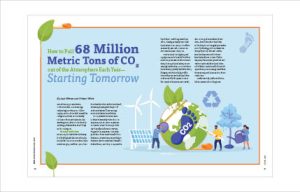How to Pull 68 Million Metric Tons of CO2 out of the Atmosphere Each Year—Starting Tomorrow
Greenhouse gas emissions. Carbon credits. Green energy technologies. These are all hot topics, and as the world scrambles to figure out how to drastically reduce carbon emissions in the coming years, there is an already existing solution that could help make an impact.
Thermal insulation. For years, the insulation industry has highlighted the cost of under-insulated areas. We tout the dollar numbers ($2.5+ Billion a year lost in uninsulated or under-insulated systems), hoping the impact of such numbers will encourage more insulation installation.
We explain how insulation is often incorrectly viewed as an expense, not an asset. Expenses are incurred and do not provide any benefits in future accounting periods. Expenses also only provide a short-term benefit for a business. In contrast, assets help a business derive economic benefits in the future, and they can provide both short- and long-term benefits. Clearly, properly installed insulation is an asset, as it offers extremely attractive return on investment year after year.
Under-insulated piping and equipment at industrial facilities includes processes with no insulation, damaged insulation, or not enough insulation. Areas with no insulation typically include valves, flanges, and other high-traffic items that are not insulated due to the need for frequent access for required maintenance activities. Damaged insulation is just that—insulation that has been walked on, has damaged protective metal jacketing, or has otherwise been physically abused. Under-insulated systems often have insulation that was installed in the past, but current practices and codes require thicker insulation. All of these result in added cost of operations, more energy used than is necessary, and increased carbon emissions.
Unfortunately, industrial insulation seems to be a forgotten technology. There are no gauges, monitoring, or computer apps to “see” its success. The benefits are instantaneous and continuous, but because they are invisible, they are generally taken for granted, which is why we think it is time to change the narrative and entice people with carbon reduction statistics.
It is a well-known fact that the use of mechanical and industrial insulation reduces carbon emissions, but for years there was not much hard data on the subject—just anecdotal numbers describing the contribution of insulation. This changed when NIA published A Study on Insulation’s Positive Impact on Energy Efficiency and Emissions Reductions, which includes reported annual numbers from major manufacturers (see www.insulation.org/carbon).
The NIA study looked at commercial and industrial markets in the United States and Canada to determine how much energy is saved and the amount of greenhouse gas emissions reduced with the use of proper insulation. Conducted using 2022 data, the study includes under-insulated areas in high- temperature markets, giving solid numbers.
The study concludes that the cost of unnecessary CO2 emissions due to under-insulated systems is, conservatively, 68 million metric tons per year. By comparison, you would need to put 14,000 windmills into operation each year to offset those 68 million metric tons of carbon. Currently, there are only approximately 95,500 windmills operating today in the United States (90,000) and Canada (5,500).
Large countries around the globe have set carbon reduction goals. In the United States, the goal is a 45% reduction by the year 2030, to reach Net Zero by 2050. But the technologies to accomplish these goals do not exist yet, or the potential payoff from many of them is years in the future. The year 2030 is rapidly approaching, so there is no time to waste in getting a start on carbon emission reductions.
If the under-insulated systems were properly insulated, the savings in 2022 alone would have been 68 million metric tons (or 14,000 windmills’ worth). And while that by itself would not achieve the 45% reduction goal, it makes a good-sized dent. Because 68 million metric tons is an annual and compounding number, if you multiply that from 2024 to 2030, you are talking about 476 million metric tons over the next 7 years, which would be equivalent to adding another 98,000 windmills—doubling the amount in existence. (An important sidenote is that it can take up to 4 years to get a windmill installed and operational, given time for permitting, construction, etc. By insulating today, you will be receiving carbon reduction results for 4 years before the windmill is functional.
To further get people’s attention, we can put numbers into perspective regarding carbon credits. These were created by the government to limit the amount of greenhouse gases organizations can emit. A company that brings its overall emissions below what is required by law can sell its excess credits to other companies that are struggling to meet the limits.
As we approach the year 2030, it is likely that carbon credits will become a hotter and hotter commodity. One carbon credit equals 1 metric ton of CO2, so imagine the market for carbon credits for a company that has some to spare. All design thicknesses of insulation deliver reductions in CO2 and NOx emissions of 88 to 98%. Drastically reducing the amount of carbon emissions a company expels means that it will have more carbon credits to use or sell.
All these emissions savings, combined with the well-established and compounding cost savings that mechanical insulation provides, makes improving areas that are currently under-insulated (or not insulated at all) a no-brainer. There is no time to waste in reducing carbon emissions. Because the technology already exists, we can—and should—put insulation to work. Immediately.

